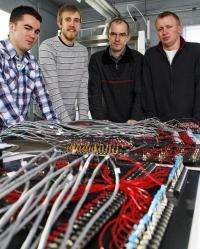Researchers cooking up new gelled rocket fuels

Engineers and food scientists are teaming up to develop a new type of gelled fuel the consistency of orange marmalade designed to improve the safety, performance and range of rockets for space and military applications.
"This is a very multidisciplinary project," said Stephen Heister, the Purdue University professor of aeronautics and astronautics who is leading one of two teams on the project, which is funded by the U.S. Army Research Office.
Gels are inherently safer than liquids because they don't leak, and they also would allow the military to better control rockets than is possible with solid fuels now used. Motors running on gelled fuels could be throttled up and down and controlled more precisely than conventional rockets that use solid propellants, Heister said.
"You can turn the engine on and off, you can coast, go fast or slow," he said. "You have much greater control, which means more range for missiles. The gelled propellants also tend to have a little more energy than the solid propellants."
Gelled fuels also could be used in thrusters to position satellites and on NASA space missions.
The team includes researchers from mechanical engineering, aeronautics and astronautics, food science, and agricultural and biological engineering at Purdue, as well as researchers from Iowa State University and University of Massachusetts.
Paul Sojka, a professor of mechanical engineering and an associate director of the project, is building an experiment to take high-speed videos of the gelatinous fuel's behavior. Jets of the gel form during the fuel-injection process.
"These jets are wiggling, there are pulsations, and those pulsations, we believe, lead to the formation of specific spray patterns and droplet formation," Sojka said. "The fluid mechanics of gels are quite challenging. The viscous properties of the gel change depending on how fast it's flowing, which is not true of common liquids such as water or gasoline."
The project will tap the expertise of food scientists and food engineers, who are accustomed to working with gels, said Carlos Corvalan, an associate professor of food science.
"Gels are more complex than ordinary solids and fluids," Corvalan said. "Fluids are characterized by viscosity, and solids are characterized by elasticity. Because gels share properties of both solids and fluids, they possess viscoelastic properties, or a combination of both."
Food science and agricultural engineering researchers will study these viscoelastic properties and create simulations describing how the gels behave.
The five-year, $6.4 million "spray and combustion of gelled hypergolic propellants" project is a U.S. Army Multidisciplinary University Research Initiative, or MURI. Another team is led by Pennsylvania State University.
Future rockets could require that gelled propellants be sprayed by fuel injectors into a motor's combustion chamber at rates of thousands of pounds per second. Using the gelled propellants, however, will require a thorough knowledge of how the fuel breaks into droplets as it is being sprayed into the chamber.
The fuels are hypergolic, meaning they require no ignition source but ignite spontaneously when mixed with an oxidizer. The fuel and oxidizer tanks each feed into a separate fuel injector. As the streams of fuel and oxidizer mix, they form droplets that ignite.
"There is an unsteadiness of these two jets, and these fluctuations can have all sorts of ramifications in terms of engine performance," said Sojka, who specializes in research to learn what happens between the fuel and oxidizer streams as they form elliptical sheets, spaghetti-like strands and droplets.
The high-speed movies are recorded at about 10,000 frames per second, or roughly 300 times faster than the typical video signal.
The collision of fuel and oxidizer jets causes "impact waves."
"We are trying to understand the source of those waves and be able to control or capitalize on the unsteadiness to make smooth combustion," Heister said.
Purdue faculty members and graduate students are conducting experiments at the university's Maurice J. Zucrow Laboratories, in the Department of Food Science and in the School of Agricultural and Biological Engineering aimed at developing a comprehensive spray model that describes the precise behavior of propellant droplets in a rocket motor.
One aim is to be able to consistently create the relatively small, uniform droplets that would be needed for rocket propulsion. Food scientists are familiar with processes used to create droplets in foods.
"The texture of those foods is closely associated with the average size and range of sizes of droplets," said Osvaldo Campanella, a professor of agricultural and biological engineering. "In a combustion chamber you also want to control droplet size, but for a different reason - to precisely control combustion. You want uniform combustion, and for that you need controlled drop size."
Corvalan will lead work to develop simulations that determine the viscoelastic behavior of the gels and droplets.
Researchers will first work with water-based gels that simulate fuels and will eventually conduct experiments using actual propellants.
"It's kind of like orange marmalade without the rind," Heister said. "We are going to make this gel and push it through holes and study how it flows and how big the drops are. Eventually we'll study the real gelled fuels, which can be quite hazardous and reactive, so we will use them in small quantities and under tightly controlled conditions."
The viscoelastic properties of the gels will not only be experimentally measured, but molecular models representing the gels also will be developed as part of research in Purdue's Department of Chemistry. The models will enable researchers to predict the behavior of gels and optimize their formulations.
Information from experiments and modeling will be used to design systems that have improved combustion.
Timothee Pourpoint, a research assistant professor of aeronautics and astronautics, is in charge of setting up and maintaining a propulsion lab to test the fuels at Zucrow. Because the fuels being tested are toxic, the lab will be equipped with a specialized ventilation system. Pourpoint conducted extensive research on hypergolic fuels for his doctoral thesis at Purdue.
Source: Purdue University



















